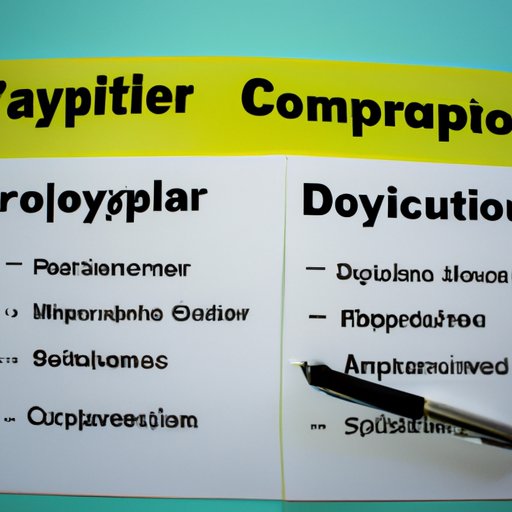Introduction
When you purchase health insurance, it’s important to understand the terms and conditions of your plan. One of the most important factors to consider is the deductible, which is the amount of money that you must pay out-of-pocket before your health insurance plan begins paying for covered services. In this article, we’ll provide a comprehensive guide to understanding deductibles in health insurance.
A Comprehensive Guide to Understanding Deductibles in Health Insurance
What is a Deductible?
A deductible is the amount of money that you must pay out-of-pocket before your health insurance plan begins paying for covered services. This means that if you have a $1,000 deductible, then you will be responsible for the first $1,000 of medical expenses before your insurance company will cover any of the costs. After you have paid your deductible, your insurance company will typically cover a portion of the remaining costs.
How Does a Deductible Work?
Deductibles are typically set up on an annual basis, meaning that once you have paid your deductible for the year, your health insurance plan will begin covering some or all of your medical expenses. For example, if you have a $1,000 deductible and you incur medical expenses totaling $1,500, then you will be responsible for paying the first $1,000 and your health insurance plan will cover the remaining $500. However, if you have not yet met your deductible for the year, then you will be responsible for paying the entire $1,500.
Different Types of Deductibles
There are two main types of deductibles: individual and family. An individual deductible applies only to the person who has the health insurance policy, while a family deductible applies to all members of the family who are covered by the policy. In addition, some health insurance plans may have separate deductibles for specific services, such as prescription drugs. It’s important to check with your health insurance provider to understand the specifics of your plan.
How a Deductible Can Affect Your Out-of-Pocket Costs
Understanding Your Deductible
It’s important to understand how your deductible works so that you can make informed decisions about your health care. Knowing how much you need to pay out-of-pocket before your health insurance plan begins paying for services can help you budget for medical expenses. It’s also important to understand that your deductible may change from year to year, so it’s important to stay up-to-date on the terms of your health insurance plan.
The Impact of a Higher Deductible
Choosing a higher deductible can have a significant impact on your out-of-pocket costs. Generally speaking, the higher your deductible, the lower your monthly premiums will be. However, you should keep in mind that a higher deductible means that you will be responsible for a larger portion of your medical expenses before your health insurance plan begins paying for services. Therefore, it’s important to weigh the pros and cons when deciding on a deductible amount.

Explaining the Difference Between a Copayment and a Deductible
What is a Copayment?
A copayment is a fixed amount you pay for a medical service at the time of service. Copayments are typically associated with doctor visits and prescriptions, and they are usually a set fee, such as $20 or $30. Copayments do not count towards your deductible, so they are an additional cost that you must pay out-of-pocket.
How a Copayment Differs from a Deductible
Unlike a deductible, a copayment is a fixed amount that you must pay each time you receive a covered service. A deductible, on the other hand, is an amount that you must pay out-of-pocket before your health insurance plan begins paying for services. Copayments do not count towards your deductible, so you must still meet your deductible before your health insurance plan begins paying for services.

What You Need to Know About Deductible Limits in Health Insurance
Maximum Out-of-Pocket Limit
Most health insurance plans have a maximum out-of-pocket limit, which is the total amount that you are responsible for paying out-of-pocket each year. This includes both your deductible and any copayments or coinsurance that you may owe. Once you reach this limit, your health insurance plan will cover all of your remaining medical expenses for the year.
Annual Deductible Limit
In addition to the maximum out-of-pocket limit, some health insurance plans may also have an annual deductible limit. This is the maximum amount that you are responsible for paying out-of-pocket before your health insurance plan begins paying for services. If you reach this limit before you reach your maximum out-of-pocket limit, then your health insurance plan will begin covering some or all of your remaining medical expenses for the year.
The Benefits of Having a High Deductible Health Plan
Lower Premiums
One of the primary benefits of having a high deductible health plan is that it typically comes with lower monthly premiums. This can be a great option for those who don’t anticipate needing a lot of medical care throughout the year. Lower premiums can also be beneficial for those on a tight budget, as it can help to keep health care costs down.
Flexibility in Choosing Health Care Providers
Another benefit of having a high deductible health plan is the flexibility it provides in choosing health care providers. Since you are responsible for a larger portion of your medical expenses before your health insurance plan begins paying for services, you can choose to receive care from any provider that is covered by your plan, regardless of whether or not they are in-network.

How Deductible Waivers Can Help Reduce Your Health Care Costs
What is a Deductible Waiver?
A deductible waiver is an agreement between you and your health insurance provider that allows you to avoid paying your deductible. This is typically offered as part of a special program or promotion, and it can be a great way to reduce your out-of-pocket costs.
How Deductible Waivers Work
Deductible waivers typically require you to meet certain criteria in order to qualify. This can include having a certain type of health insurance plan, using specific health care providers, or completing certain tasks or activities. It’s important to check with your health insurance provider to find out what you need to do in order to qualify for a deductible waiver.
Conclusion
Deductibles can be confusing, but understanding how they work can help you make informed decisions about your health care. Deductibles are typically set up on an annual basis, and they can vary depending on the type of plan you have. It’s important to understand how your deductible works and how it can affect your out-of-pocket costs. Additionally, it’s important to understand the difference between a copayment and a deductible. Finally, it’s important to understand the maximum out-of-pocket limit and annual deductible limit associated with your health insurance plan. Having a high deductible health plan can offer several benefits, including lower premiums and more flexibility in choosing health care providers. Finally, deductible waivers can be a great way to reduce your out-of-pocket costs.
(Note: Is this article not meeting your expectations? Do you have knowledge or insights to share? Unlock new opportunities and expand your reach by joining our authors team. Click Registration to join us and share your expertise with our readers.)
